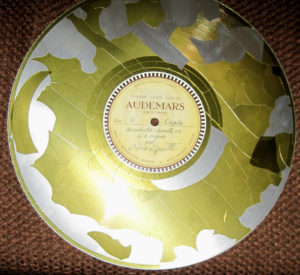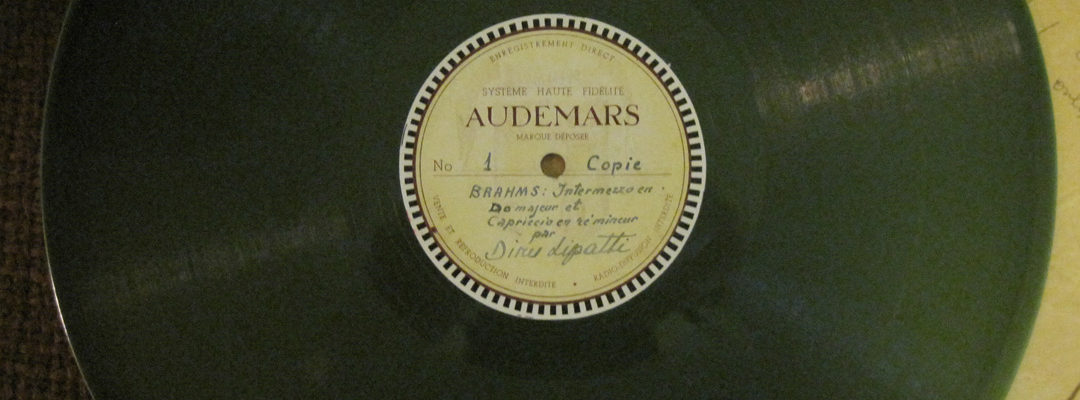In early 2008, I was received an email from pianophile Allan Evans with the subject title ‘Mission Impossible?’ In this message, Evans stated that a collector might have some private discs of Lipatti and invited me to call him, which I did. He told me that a series of private discs that came from a Geneva estate had ended up in the Brooklyn collector’s hands but he was not being forthcoming with allowing the discs to be transferred, so Evans wondered if I might have more success than he had. A few months later, I visited the collector with International Piano Archives co-founder Gregor Benko, and the fellow showed us a box full of records with Lipatti’s distinctive handwriting on the labels, some of which listed the names of compositions, while others simply had the name of a composer or Lipatti’s own name. However, we too were not able to obtain copies at the time of our visit, but we had a congenial conversation and stated that we would keep in touch to arrange a transfer; unfortunately, future discussions, while also friendly, yielded no commitment to transfer the records.
When the collector died a few years later, his and Benko’s mutual friend Joseph Ganun of Academy Records contacted Benko that he had the records and arranged for him to make copies with master engineer Ward Marston, and the performances were secured for issue on that label’s Landmarks of Recorded Pianism Vol.1.

Unfortunately, of the several discs in the collection, only five titles could be salvaged, as several discs had deteriorated beyond repair, as the photo on the left shows. Of these works, several titles were new to Lipatti’s discography, among them a Scarlatti Sonata and two works by Brahms.
It is postulated that the recordings were made in 1945-46: all the compositions on the records in this collection were in Lipatti’s solo programmes that season, and in this collection were transcription discs of the world premiere concert performance of Lipatti’s Danses Roumaines, which was broadcast live on October 10, 1945. All of the discs also featured the same ‘Audemars’ company’s label, so it can be safely assumed they were recorded around the same time.
Lipatti put two Scarlatti Sonatas on disc for EMI in 1947, but regrettably the ones he recorded were not works that lend themselves to particularly creative interpretative possibilities, and therefore they did little to reveal Lipatti’s imagination and pianistic mastery. In this batch, there were three Scarlatti Sonatas that were salvaged, although two existed in other recordings by the pianist: one of them for EMI (the D Minor K.9) while another in G Major (K.14) was recorded by the artist (in an abbreviated form) in Bucharest in 1941. Unfortunately the disc with yet another Scarlatti Sonata that he didn’t record commercially – one in B-Flat Major – was too damaged to be played, as can be seen in the photo above.
However, it is most fortunate that the Sonata in G Minor K.450 survived, as it demonstrates Lipatti’s musical genius and technical mastery to a remarkable degree: the pianist uses transparency of voicing, mindful use of articulation, rhythmic vitality, and marvellous interplay between left and right hands to highlight shifts in harmonic structure and contrapuntal writing.
We can hear Lipatti playing much more freely here than in his studio recordings – and this is certainly the case in the two Brahms titles salvaged from these private discs. Lipatti recorded no solo Brahms works for EMI – his first studio recordings, however, consisted of a series of Brahms Waltzes for Two Pianos Op.39 on an HMV disc with Nadia Boulanger as well as the Liebeslieder Waltzes for singers, again with Boulanger at the second piano, both of which demonstrate his clear affinity with the composer’s idiom. However, once he signed a contract with Columbia sublabel of EMI, he recorded no works by this composer despite several of his compositions figuring in his solo programmes.
In this magnificent performance of the Intermezzo in C Major Op.119 No.3 – which is paired with the Capriccio Op.116 No.7 on the same record – we hear Lipatti playing with tremendous abandon and rhythmic vitality, much more at ease than in his official studio accounts. Particularly fascinating is Lipatti’s use of bold accents and sudden stops, dramatic gestures heard occasionally but not often in his official recordings (his 1947 take of the Chopin Waltz Op.34 No.1, for example, and his recital performance of the Schubert E-Flat Impromptu). His fluidity of phrasing and interplay between left and right hands is also beautifully accomplished.
If Lipatti had recorded this Brahms work (and the other on the record) for EMI – and played with this degree of expansiveness and vitality – our perception of him as an artist would surely be different than the prevailing view of him as a rather cautious, ‘by-the-book’ performer.
The five recordings released on the Marston Records compilation are:
Scarlatti Sonata in D Minor K.9
Scarlatti Sonata in G Major K.14
Scarlatti Sonata in G Minor K.450
Brahms Intermezzo in C Major Op.119 No.3
Brahms Capriccio in D Minor Op.116 No.7
These performances are a unique and extremely important addition to Lipatti’s discography. You can read more notes about the discs, and order this unique release, at this link on the Marston website.

Comments: 4
Wow
I wholeheartedly concur!
WOWWWWWWWWWWWWWW !
Thank you very much, dear Mark!